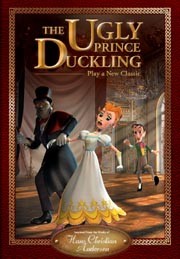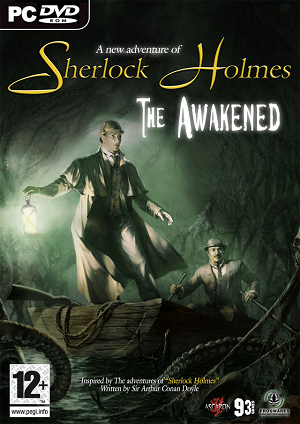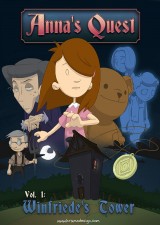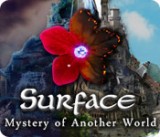Review for Dream Chronicles: The Book of Air

The popular Dream Chronicles casual games have always been something of a Myst-lite adventure experience, but now the series has pushed the meaning of “lite” to a whole new level, both literally and figuratively. Perhaps that’s fitting for a game called The Book of Air, but the fourth installment is such a short and easy excursion through the skies that it’s sure to deflate any lofty expectations of existing fans and leave potential newcomers feeling a little flat. That’s a shame, as it not only looks and sounds better than ever, it’s also the most user-friendly episode in the series so far. Unfortunately, unlike the balloon-propelled airship that transports you around, the surprisingly uninspired, simplified gameplay will prevent your enjoyment of this journey from ever getting very far off the ground.
The Book of Air casts players in the role of 17-year-old Lyra, daughter of the original protagonist. Story has always been something of an afterthought in this series, providing only the barest of frameworks to drive each adventure onward, and The Book of Air is certainly no exception. In fact, its narrative may be the least-developed of any game so far. Lyra inexplicably finds herself trapped back in her now-deserted home town of Wish. With only conveniently-placed notes from her grandfather to guide her, Lyra must open a portal and take flight on a puzzle-filled fetch quest in order to piece together a way home. There is no foil this time; no explanation for what’s going on; no justification for puzzles or purpose. Just a premise, a pat on the head, and away you go. Games like this don’t really need much more, but as the first chapter in a proposed new Dream Chronicles trilogy, there’s too little here to establish any kind of relevant foundation.
Really, though, Dream Chronicles is all about travelling to beautiful, exotic places and solving lots of puzzles. In that sense, this game gets it half right: the scenery is still lovely. You’ll travel to a house perched precariously on a towering snowbound pedestal, heal forest trees made of gold, and wander the beach of a musical fairy island, inhabited now only by crumbling statues. The graphics are crisp and nicely designed, but only mildly supported with ambient animation like the occasional drifting cloud or gust of steam. The music, too, is pleasant to listen to, playing subtly in the background to provide a gentle atmosphere, at times resembling a lullaby playing in a music box. The Book of Air even includes voiceovers this time, as Lyra makes occasional comments in a distinct, often over-emphasized British accent, and her grandfather Tangle’s notes are read aloud in his voice. A mysterious Clockmaker has some dialogue as well, though you’ll only ever get to converse with him through a mechanical mouthpiece.
The production values may meet the usual high series standards, but it all just feels so… small. I criticized the previous game for wrongly taking a “more is better” approach, but here the developers have over-compensated in reverse. The total number of locations is quite limited to begin with, and each represents an entirely standalone experience. There is still some freedom to explore a given area, but none of the lands you’ll visit include more than a few screens each, and some have as little as one. While a degree of linearity is helpful in maintaining focus on current objectives, excessive streamlining like this simplifies the experience a little too much and feels like a definite step back for the series.
The gameplay itself feels skimpy as well. You’ll encounter a decent number of puzzles along the way, but many are basic and easily solved. There are simple jigsaws and broken objects to assemble, word games to decipher, gears to connect, tiles to rotate, a Simon sequence to mimic, and dials to align. Apart from setting new airship coordinates for each new destination, very few of these puzzles are organically integrated or disguised in such a way to feel fresh and new. There is even an entire section set in Wish’s one-room school that’s ripped straight out of an earlier episode, presenting a set of symbol patterns to complete in order to crack a code. You know you’re running out of ideas when you start stealing from yourself. Perhaps it was intended for nostalgic purposes, but in a game so devoid of creativity, that isn’t a good idea.
Fortunately, some of the puzzles are fun and can even be fairly challenging, like using pegs to guide walnuts through a tree-trunk obstacle course or balancing weights with coded water measurements. There is also a collapsing coloured stone minigame required to “fuel” the airship, which can be entertaining at first. Even these wear out their welcome, however, as you’ll have to repeat many of the same puzzles multiple times, often in a row. Perhaps the only really memorable puzzle is the one that incorporates several level of clues and interactions, as you must create a group of crystal plates with the correct symbols found elsewhere, then utilize them correctly to accomplish your goal. This, too, is similar to a previous Dream Chronicles puzzle, but at least it’s one that was worth revisiting.
Also returning is the series’ trademark jewel collection. The Book of Air is decidedly NOT a “hidden object” adventure, as you’ll only ever collect a few inventory items and scattered sets of map pieces, planks, and other necessary materials, but you will have to keep a sharp eye out for tiny sparkles on each and every screen, including puzzle close-ups. The jewels serve a thinly-justified purpose, as collecting enough of them unlocks five special skills for Lyra, including the ability to read fairy text, illuminate the dark, and create storms. You’ll need all of them to finish, though some are used only once and it’s always plainly obvious when to activate one with a simple on-screen button click. I’m disappointed to see no refinement of this jewel-gathering process, as they’re still just scattered randomly, and they’re so small that finding some is literally no more than a pixel hunt. There are more jewels than you’ll need altogether, but not many, so you can’t afford to simply ignore them.
Overlooked jewels and key interactive items still twinkle occasionally to alert you to their presence, but in one very positive move, The Book of Air has finally added some other user-friendly helps the series has been sorely lacking to date. There is now a rechargeable “Locate” button that will highlight objects you may have missed, and an option to skip puzzles if you wish. The latter is only available on the “Casual” difficulty setting, however. Choosing the “Challenge” option not only makes the game more difficult, it also removes the puzzle bypass feature altogether. It’s a shame the choice is either/or, as I suspect many people would appreciate the increased challenge in such a simple game, yet not wish to be saddled with the possibility of an unskippable puzzle.
That’s about it for general accessibility, too. The game plays out almost identically to its predecessors in a simple first-person, point-and-click slideshow format, which means the cursor still doesn’t change over interactive items, and hotspot subtitles again have a small lag time before appearing. There is no list of objectives or hint option, and although there is a journal, it only records the most basic of observations in each new area. It’s a very easy game to control in general, and its relative ease means that not a lot of help is required, but it’s strange that one of the pioneers of casual adventuring should be so far behind other games in now-standard conveniences.
After just a couple hours of play time (or a bit more on the harder setting), The Book of Air abruptly ends. There is no grand puzzle sequence to overcome, no dramatic finale to experience. After completing your assigned tasks, you’ll suddenly find yourself on your way home. This being a Dream Chronicles game with more sequels in the offing, of course you won’t make it, as the “ending” is simply a showcase to indicate that your adventure isn’t over. In the Collector’s Edition, there’s an additional chapter after that, but the extra sequence is pointless and entirely anti-climactic. There is no exploration at all, just a new “dream” that allows you to repeat two different puzzles (anagrams and tile jigsaws) several times in exchange for some concept art of previous locations. The last one hints at the “Book of Water” in Lyra's future, which is your cue to shut the game off, since there isn’t even the courtesy of a proper conclusion beyond that. This is by far the lamest gameplay “bonus” material I’ve ever encountered, so don’t even consider it unless you’re a sucker for in-game strategy guides, music samples, and artwork.
Despite all the criticism, the fourth Dream Chronicles installment is not a bad game in any respect. It’s still a breezy bit of escapist fun if you like lonely adventures through picturesque fantasy worlds. But you’d better like them short, easy, and without much inspiration, as there’s just nothing here that makes the game stand out. Like the airship that powers it, The Book of Air has all the earmarks of a series that’s running out of gas, and since there is more yet to come, here’s hoping the developers go back to the drawing board to come up with something that will really blow us away.




























